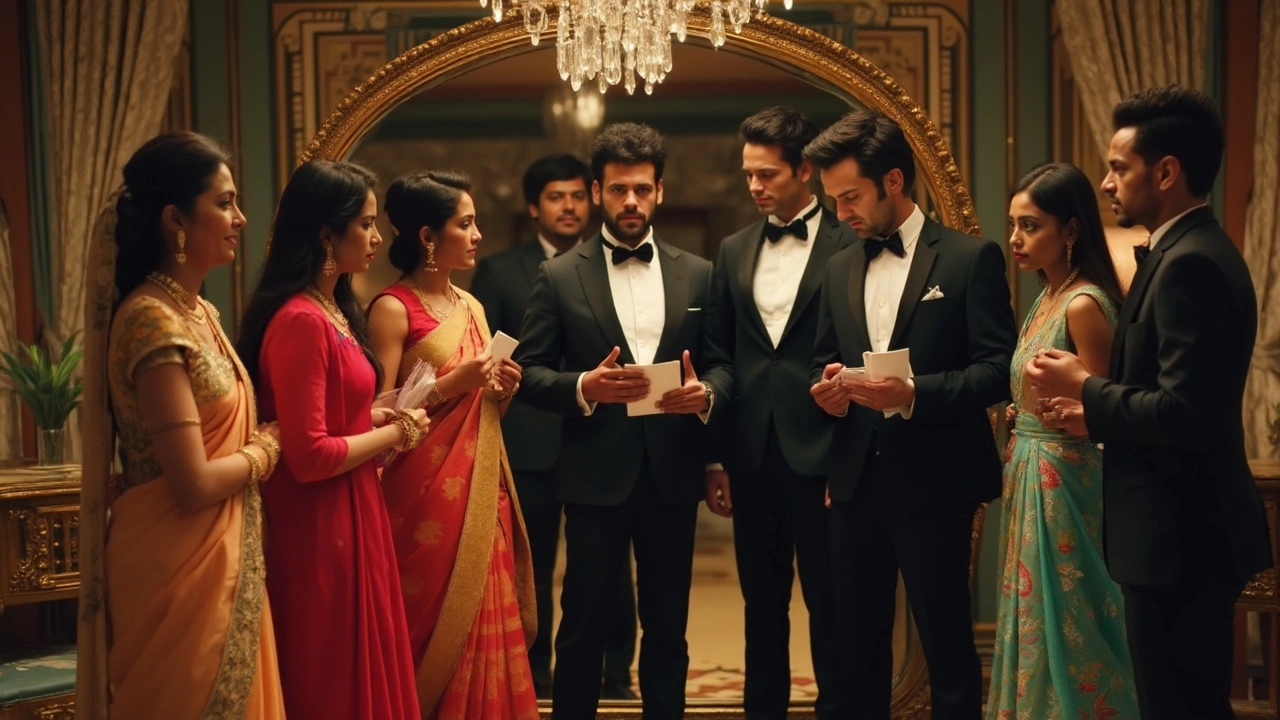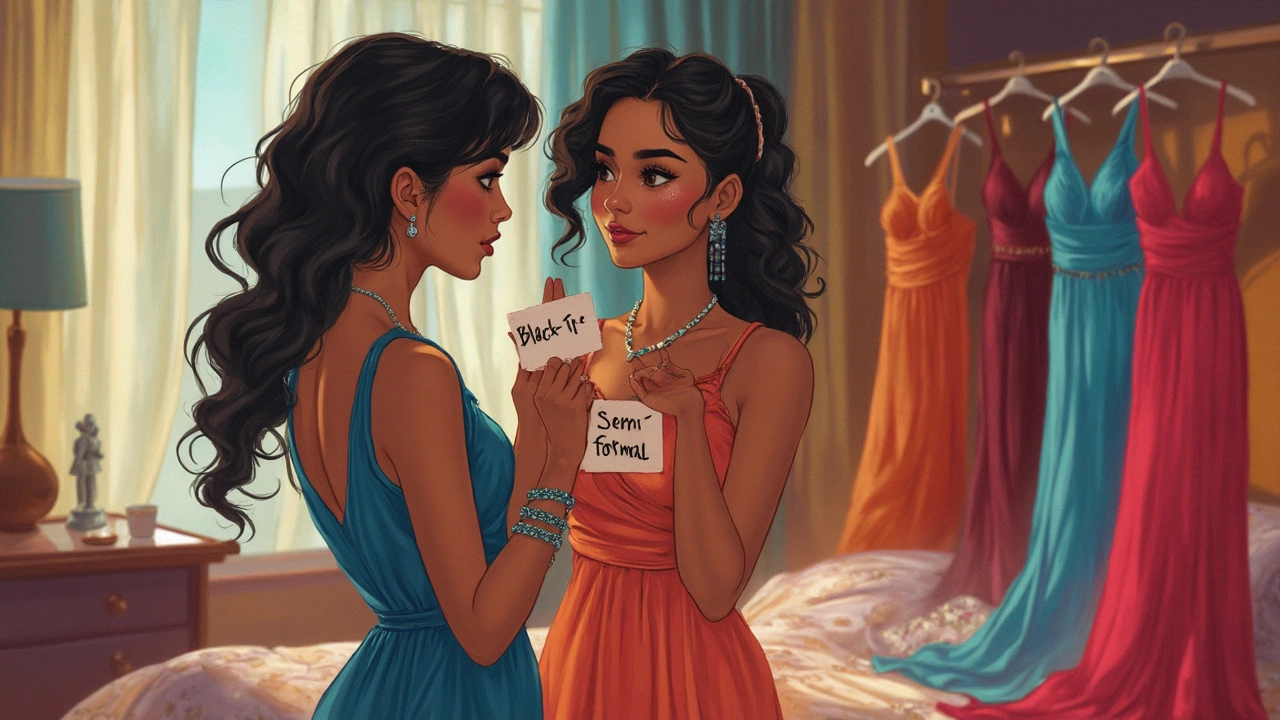Evening Dress Code: What You Actually Need to Know

Ever get invited to an evening event and end up staring at the dress code, confused? You’re not alone. Half the time, the phrase on the invite is more mysterious than helpful. 'Cocktail?' 'Formal?' 'Evening casual?' It can get weird fast—and honestly, it’s never as strict as people make it out to be.
Here’s the honest truth: Most hosts just want you to look polished and comfortable. If you know the basics—like what separates black-tie from cocktail, or when it’s okay to dress down a little—you’ll never panic again. Figuring out what's best for the situation is about matching the vibe, not following a rulebook from a hundred years ago.
Let’s get this sorted, so you show up feeling confident and like you totally belong. No more standing at your closet, texting your group chat for help. Ready to be the person everyone comes to for fashion advice? Let’s break these codes down in plain English.
- What Common Dress Codes Really Mean
- How to Read Between the Lines on Invitations
- Go-To Evening Outfit Ideas
- Tips to Never Feel Under or Overdressed
What Common Dress Codes Really Mean
Seeing a dress code on your invite can feel like a pop quiz, but once you crack the code, it's easy. There are only a handful most people actually use. Let’s get straight to what each one really means, without the guesswork.
- Black-Tie: This is the classic "fancy night" look. For women, that means a floor-length gown or a classy cocktail dress, usually in darker colors. High heels are expected, but block heels or dressy flats totally count if you’re not into sky-high stilettos. For men, it’s a tuxedo—always.
- Formal (a.k.a. Black-Tie Optional): This asks for elegance but is a bit more chill. Women should go for a long dress, tailored jumpsuit, or a really upscale cocktail dress. Think dressy, but not over-the-top. Guys can pick a dark suit if they don’t own a tux.
- Semi-Formal: Here, you have more freedom. Women can do cocktail dresses, jumpsuits, or smart separates. Heels or nice flats both work. For men, a suit and tie get the job done. Basically, look sharp but don’t dress so fancy that you outshine the wedding cake.
- Cocktail: This one is everywhere. Shorter dresses (knee-length or a bit above), statement jumpsuits, and coverage that’s not too revealing—think "party but classy." This is a go-to vibe for most events after 6 PM.
- Casual or Dressy Casual: Probably the trickiest because it sounds relaxed, but guests still want to look like they tried. Here, a stylish sundress, a skirt and blouse, or even tailored pants work well for women. Keep it fun but polished. Flats, sandals, or pumps—pick what feels comfortable.
Most events use these five. Some add quirky stuff, but rarely. Here’s a cheat sheet for quick reference:
| Dress Code | Most Common Outfits (Women) | Footwear |
|---|---|---|
| Black-Tie | Floor-length gown, dressy cocktail dress | Heels, dressy flats |
| Formal | Evening dress, tailored jumpsuit, upscale cocktail dress | Heels, smart flats |
| Semi-Formal | Cocktail dress, jumpsuit, separates | Heels, flats |
| Cocktail | Knee-length dress, party jumpsuit | Heels, flats |
| Dressy Casual | Sundress, skirt and top, tailored pants | Flats, sandals, pumps |
If you’re ever unsure, just remember: it's easier to dress a bit up than to feel like you didn't try hard enough. Most people stress about being overdressed, but no one ever minds when you look put-together. Highlight evening dress code suggestions that feel true to your style, and you’ll nail it every time.
How to Read Between the Lines on Invitations
People like to think they’re being clear with dress codes, but let’s be real—they aren’t. Invitations almost never spell out exactly what you should wear. The words they use can actually mean different things depending on who’s hosting, where it is, and even what day of the week it falls on.
If you see words like “black-tie,” “formal,” or “cocktail” in the invite, grab your best outfit. If the invite says “evening casual” or just “evening,” it usually means dressier than what you’d wear to lunch, but not prom-level. When in doubt, the clues are in the details—they might drop the venue name, mention outdoor vs. indoor, or even note the party’s start time (later usually means more formal).
- If it says "Black-Tie": Go for a long, dressy gown or classic cocktail dress. Gloves and heels = optional, not mandatory.
- "Formal": Still dressy, but you have more wiggle room. Midi or long dresses work. Go for fabrics like satin, silk, or velvet if you want to feel fancy.
- "Cocktail": Knee-length or playful midi dresses. You can play with color and style more.
- "Evening Casual": Think jumpsuits, nice skirts with elegant tops, or classic little black dresses. You don’t need sequins—unless you want them!
Fun fact: According to a 2023 survey by The Knot, about 60% of guests said they still text the host for clarification on the dress code. It’s totally normal if you have to double check, especially if the event details are fuzzy.
If you’re still puzzled, peek at the invite for:
- Venue: Private club or hotel? Dress up. Backyard or brewery? Tone it down a notch.
- Timing: After 6 pm is your clue to lean dressy.
- Season: Warmer months are lighter fabrics; winter = deeper colors and heavier fabrics.
- Host’s style: If you know them, think about what they usually wear to events.
| Dress Code | Go-To Outfit | Typical Venue |
|---|---|---|
| Black-Tie | Floor-length gown | Banquet hall, ballroom |
| Formal | Long or midi dress | Country club, fancy restaurant |
| Cocktail | Knee/midi dress | City loft, downtown lounge |
| Evening Casual | Dressy separates, smart jumpsuit | Backyard, casual bar |
Bottom line: Don’t get stuck overthinking. Most hosts are just glad you made an effort, and the evening dress code is usually more relaxed than you think. And remember, you can always ask for details—people do it all the time!

Go-To Evening Outfit Ideas
Finding the right outfit doesn’t have to be stressful once you know what *actually* works for each type of evening event. The trick is understanding what’s expected, then putting together something you feel great wearing.
Let’s break it down by the most common evening dress codes. Don't forget: fit and comfort beat out trendiness every single time.
- Black-Tie: Here’s where you go big. For women, a floor-length gown is classic, but a sleek cocktail dress (just above or below the knee) in rich fabrics like silk or velvet works too. Stick to darker colors or jewel tones. Don’t forget some sparkle—think statement earrings or a bold clutch.
- Cocktail: This one gives you options. Pick a fun knee-length dress or a chic jumpsuit. Patterns and colors are totally fine—just avoid super casual fabrics like denim or cotton jersey. Throw on some heels, a playful clutch, and you’re golden.
- Semi-Formal: Go for something dressy but not too over the top. Midi dresses, wrap styles, or a tailored pants-and-nice-top combo are awesome here. Block heels nail the comfort + style combo, especially if you’ll be standing or dancing a lot.
- Evening Casual: Honestly, this usually means "look put-together." Think: stylish sundress, dark jeans with a nice top, or a skirt and a crisp blouse. Add edgy sandals or ankle boots and keep the makeup and jewelry a bit lighter.
Worried about making the wrong call? Accessory swaps can save you. If you bring a pair of flats and a statement necklace, you can dress things up or chill them out with zero drama.
To give you an idea of what people actually wear, here’s some real-world data from a 2023 survey by Rent the Runway. It shows what types of evening looks are most popular:
| Dress Code | Most Chosen Outfit | % of Respondents |
|---|---|---|
| Black-Tie | Full-Length Gown | 62% |
| Cocktail | Cocktail Dress | 71% |
| Semi-Formal | Midi Dress or Jumpsuit | 54% |
| Evening Casual | Dressy Top & Dark Jeans | 48% |
One more thing—if you’re ever really stuck, you can’t go wrong sticking with the classic evening dress code rules above, and just dialing up or down with accessories. Worst case? You’ll be the most put-together person there, and no one ever regrets that.
Tips to Never Feel Under or Overdressed
There’s nothing worse than walking into a room and realizing your look is way off base. But there are easy ways to prevent this. Start by actually reading the invite—if it mentions a specific code like evening dress code or 'cocktail attire,' stick pretty close to it. Most people stress over the words when really, these are just guidelines so you don’t show up in jeans when everyone’s wearing dresses.
If you’re still unsure, check the host’s social media or text someone else invited. A simple, 'What are you wearing?' can save you from a fashion panic. You can even look for past event photos; this is how people figure out what flies for different friend circles and venues.
Accessories and layers are your rescue kit. Not sure if you’re too plain? Add bold earrings or a dressy clutch. Think you might be over the top? Bring a simple jacket or cardigan you can throw on to downplay your outfit. The same trick works for shoes—if you’re not sure, pack some flats and change if needed.
- Always keep a neutral, just-in-case dress in your closet. Black never fails for evening events, and it’s easy to dress up or down.
- Avoid anything too revealing for events with family or work contacts—you won’t regret playing it a bit safe.
- If you’re trying something trendy or bold, balance it with something classic. For example, wild heels with a simple dress.
- Don’t be afraid to ask the host directly. A quick message is better than hours of second-guessing.
Finally, remember: Confidence makes anything look better. If you’re comfortable and feel like yourself, you’ll blend in even when you’re technically a little overdressed or underdressed. People notice smiles and good energy more than a label or fabric.
- May, 13 2025
- Violet Greenfield
- 0
- Permalink
Written by Violet Greenfield
View all posts by: Violet Greenfield